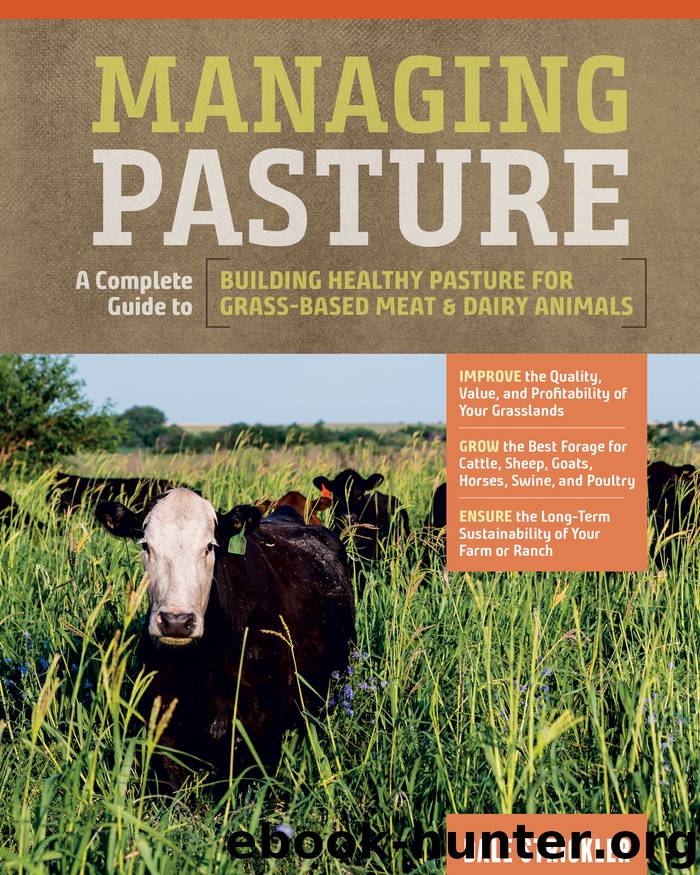Managing Pasture by Dale Strickler

Author:Dale Strickler
Language: eng
Format: epub
Tags: managing pasture
Publisher: Storey Publishing, LLC
Published: 2019-03-06T20:54:58+00:00
Cool-Season Annual Grasses
Providing nutritious pasture later in the fall and earlier in the spring than perennial forages, cool-season annual grasses extend the high-quality grazing period in both directions.
Cereals
Many cereals do double duty as grain crops and cool-season forages.
Wheat is obviously grown primarily as a grain crop, but there are many acres of it used as a “dual-purpose” crop, in which the crop is lightly grazed until the jointing stage, and then animals are promptly removed. Grazing in this manner does little harm to grain yields, and the grazing can be considered as a bonus crop. If grazing continues after jointing, however, the grain yields decline rapidly. This practice is mostly utilized in the southern Plains states of Kansas, Oklahoma, and Texas. Farther north, the length of the vegetative period becomes progressively shorter, and the value of wheat pasture diminishes.
Winter wheat can also be planted as a dedicated pasture with no intention of harvesting a grain crop (“graze-out wheat”). Some producers will plant wheat and make the decision to harvest grain or graze out based on the price of wheat grain in the spring. As a winter pasture, wheat is less productive than most other cereals if the intention is pasture alone. If wheat is to be pastured, increase the seeding rate by 50 percent and increase the amount of fertilizer applied. Each 100 pounds of beef produced from wheat pasture requires about 40 pounds of nitrogen and 4 pounds of sulfur.
Wheat varieties differ greatly in pasture value. Varieties developed by the Oklahoma State breeding program ordinarily pasture very well, since pasturing wheat is an important practice in Oklahoma and therefore a focus of the breeding program there. Other varieties are intended to be managed for “pasture only.” The variety Willow Creek was developed to remain in a vegetative state as much as a month longer in the summer than grain varieties, offering a much longer grazing period.
Download
This site does not store any files on its server. We only index and link to content provided by other sites. Please contact the content providers to delete copyright contents if any and email us, we'll remove relevant links or contents immediately.
Craft Beer for the Homebrewer by Michael Agnew(17447)
Marijuana Grower's Handbook by Ed Rosenthal(3119)
Barkskins by Annie Proulx(2880)
Project Animal Farm: An Accidental Journey into the Secret World of Farming and the Truth About Our Food by Sonia Faruqi(2661)
Red Famine: Stalin's War on Ukraine by Anne Applebaum(2464)
The Plant Messiah by Carlos Magdalena(2454)
Organic Mushroom Farming and Mycoremediation by Tradd Cotter(2307)
0041152001443424520 .pdf by Unknown(2220)
In the Woods by Tana French(1997)
Beer is proof God loves us by Charles W. Bamforth(1921)
The Art of Making Gelato by Morgan Morano(1900)
Meathooked by Marta Zaraska(1886)
Birds, Beasts and Relatives by Gerald Durrell(1863)
Reservoir 13 by Jon McGregor(1852)
The 7 Habits of Highly Effective People: Powerful Lessons in Personal Change (25th Anniversary Edition) by Covey Stephen R(1836)
Borders by unknow(1786)
The Lean Farm Guide to Growing Vegetables: More In-Depth Lean Techniques for Efficient Organic Production by Ben Hartman(1785)
The 7 Habits of Highly Effective People: Powerful Lessons in Personal Change by Stephen R. Covey(1765)
Urban Farming by Thomas Fox(1749)
